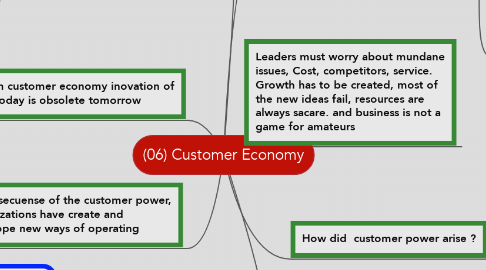
1. Business is about execution
1.1. Having an idea for a product does you no good if you cant develop it an deliver it
1.2. Managment is one of the most risky, complex and uncertain activity
1.2.1. The challenges of management are extraordinarily difficult.
1.2.1.1. Customers stopped tolerating abuse from suppli- ers who condescended to fill their orders, They refused to accept high prices, low quality, and dreadful ser- vice. Instead, customers now instruct their suppliers
2. In consecuense of the customer power, organizations have create and develope new ways of operating
2.1. Just in time, TQM, Six sigma,
2.2. Management innovations enabled these companies to develop better products quicker, and to manufature them more realiably and lower cost
3. In customer economy inovation of today is obsolete tomorrow
3.1. Customer power must be reflected in how a company is managed, from how work is done to how people are rewarded to how it is organized
3.1.1. adapting every aspect of business to the reality of customer dominance
4. The agenda for the customer econo- my has nine element
4.1. The first two translate platitudes about customers into concrete action by distinguishing companies from look-alike competitors and creating loyal customers
4.2. Items 3 and 4 deal with process
4.3. Principle 5 demands a new approach to measurement—one that locates it squarely in the center of a systematic approach to improving per- formance
4.4. tems 7, 8, and 9 harness Internet power to link companies.
4.4.1. Companies must knock down the walls that add overhead and inefficiency, through col- laboration and inter-enterprise process integration, and position themselves as omponents of virtually extended enterprises
5. Leaders must worry about mundane issues, Cost, competitors, service. Growth has to be created, most of the new ideas fail, resources are always sacare. and business is not a game for amateurs
6. How did customer power arise ?
6.1. Exceed demand, hight manufacturing productivity reduced costs, and globalization led to me more competitor
6.1.1. roles have changed, and sellers have become supplicants for scarce buyers
6.1.2. Information technology (including the Internet) enabled them to find and analyze competing products and to make intel- ligent choices
6.1.2.1. Customers have become more sophisticated and informed buyers
6.1.3. Rapid changes in technology shorten product life-cycles. New products soon become obsolete or imitated. Many similar offerings make it difficult to differentiate—and this further empowers customers.
6.2. The new customer economy is still gatheriiig steam
7. Go from leader to customer-centric
7.1. To make the sliift, employ three strategies.
7.1.1. 1. Customers in the boardroom
7.1.1.1. Get feedback from customers on prtjcesses that determine their experience. Leaders need to model listening to customers.
7.1.2. 2. Leaders in the customer's loorl
7.1.2.1. Customer-centric leaders hunt for gen- uine encounters with customers. Spend time in the field where the action is lively
7.1.3. 3.-Customers on the dashboard
7.1.3.1. By giving direc- tion, alteration, mainte- nance, and early warning, dashboards provide part of the guidance system need- ed to traverse the market- place.
